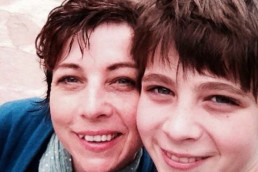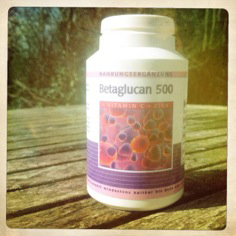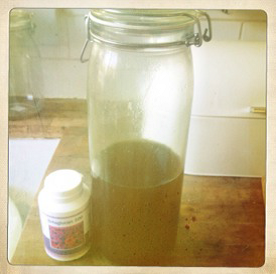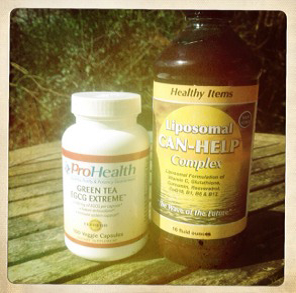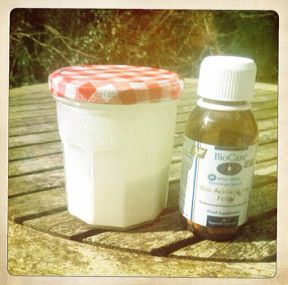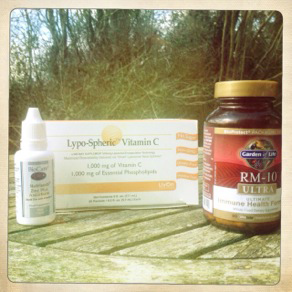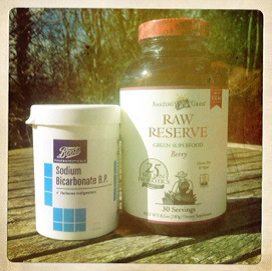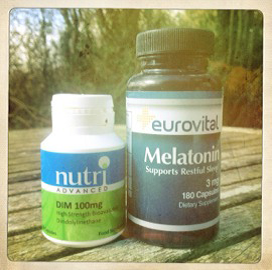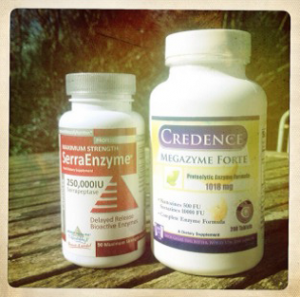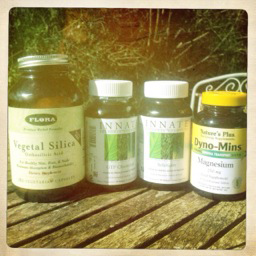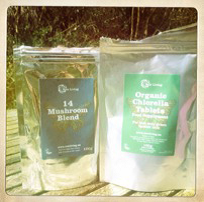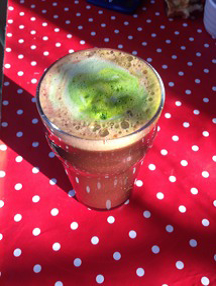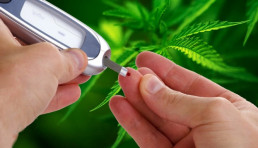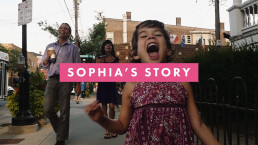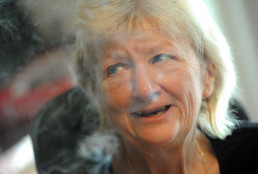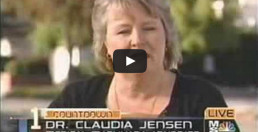Medical Marijuana Stories: Healing from Stage 4 Cancer
Medical Marijuana Stories: Healing from Stage 4 Cancer
Rosa is a mother, a Cannabis Crusader and an expert in alkaline state and alternative healing. Our friend and supporter from day one, she is in a battle to fight her aggressive Sarcoma cancer. The size of her tumour has shrunk from 8 cm to 2 cm, but also regrows anytime; the battle is constant but she remains strong. Here, in this treatment diary, Rosa lists all the healing supplements that have maximised her cannabinoid receptors and the diet she uses.
Rosa’s Protocol – Healing from Stage 4 Uterine Leiomyosarcoma
This document is to share my experience about what is working for me in healing myself from Uterine Cancer, using Cannabis Oil along with a clean alkaline diet, well researched supplements & last but by NO MEANS LEAST emotional clearing work. Hope this helps some of you on your healing journeys.
I had a hysterectomy for “ Fibroids” in 2013, I found out 2 months later that it was cancer. It had soon spread to my lungs and after various surgeries and traditional treatments I finally got hold of a good quality 1:1 cannabis oil, and it stopped me limping in 2 days, after 4 days I felt the tumour shut down. Phew. It’s a work in progress. Here’s what else I’m doing:
First thing, a huge glass of lemon water & 2 of these babies: Betaglucans, a super potent immune booster. (x 2 on an empty stomach).
Essiac Tea. From an ancient native Amercian recipe. Tried and tested this one’s been around for a long time. Replaces lost minerals which most cancer patients are deficient in. I drink 1 – 3 cups, sipped, on an empty stomach.
These are the stars of the show!
Liposomal “Can- Help” from Healthy Items, contains: Liposomal Vit C liposomal Curcumin, Resvertarol, Q 10 and B vits. 1 – 3 tsp per day.
Green Tea EGCG. 2 caps 30 mins before dosing with Cannabis Oil to clear CB receptors (which can get blocked so that the cannabinoids cant “sit” on the receptors and do their funky thing.)
Bravo Probiotic is very expensive, but helps the body make its own GCMAF which is what the macrophages use to fight cancer cells. 1 jar per day. As a cheaper alternative “Chuckling Goat” do a good kefir ( type of probiotic ).
I’m thinking of adding powdered colostrum to it as that’s whats in the Bravo. Colostrum is in our mothers milk and is what originally nourished our immune systems as babies.
Bio-care Bio Acidophillus Forte. 2 per day
IMMUNE SUPPORT
3 grams a day of Liposomal Vit C. It’s meant to be even more effective than IV Vit C. Anti – inflammatory and Anti-Cancer. I take as much as 10g a day if I’m having a flare up. This works very well for me in conjunction with a good quality 1:1 Cannabis Oil. If i had to choose 1 supplement (alongside the Cannabis Oil ) It would be this.
Biocare or Nutri Vit D3. 10 drops per day. I forgot this recently and really noticed the difference and Biocare liquid Zinc 10 drops. My body loves Zinc.
ALKALISERS
Raw Reserve Berry Flavour
Finally a green powder with all the key grasses and algaes that doesn’t taste like pond water. Update: Its got MACA in so no good for hormone sensitive cancers, like mine, so stopped this one and am taking their neat wheatgrass powder. Great for travelling. Although I travel with a juicer. 1 Tablespoon per day.
Sodium Bicarbonate. 1 Tablespoon per day. The most effective alkaliser in my opinion. Between meals. Not for prolonged periods apparently.
DIM – natural oestrogen – Inhibitor x 2 per day. Without the side effects.
Melatonin – studies show that it stops metastasis, we like that. It balances the pituitary gland. I have had no new metastasis since I’ve been taking this. 20 mg before bed.
ENZYMES
Serraenzyme from Silk worms, helps break down the fibrin coating the tumour so the cannabis oil can get in. Bring it on! x 3 250 000IU Per day
Credence Megazyme Forte Proteolytic Enzymes. x 3 per day
MINERALS – INNATE RESPONSE OR CYTOPLAN SELENIUM
400 Mcg per day Selenium is responsible for over 300 cellular activities and its not really in the soil much any more. This is also No1 for Cancer prevention. Get it in you and everyone you love.
Magnesium x 2 250 mg per day. Plus 30 sprays of magnesium OIL on the skin. so relaxing. Mag is key for so many processes in the body and is depleted by stress. GTF Chromium x 2 per day, plus FLORA Silica x 2 per day and Biocare B Vit complex x 1 per day.
Chlorella x 5 tablets a day. Detoxifying, balancing and draws out heavy metals, what’s not to like?
NB At the beginning of my healing journey I did a lot more intensive detoxing, juice fasts, coffee enemas – still do ) Infra red saunas, and supplements like Pectasol. Now I’m clean as a whistle . Perk of having cancer = no cellulite.
14 Mushroom Blend – Immune Support. I use this in cooking, tastes great and its RAW. Raw food contain many times more enzymes than cooked food. And we like enzymes, they help everything to work really well.
Juicing Organic vegetables (not much fruit) detoxes the body and floods it with nutrients. The lack of fibre means the body doesn’t have to work at all to get the nutrients. Our bodies love this.
I drink 1 pint ( 24 oz approx ) a day. But earlier in my journey I was on 2 or 3 pints of veg juice a day. Drink as much as you can, and don’t pre-prepare it or the enzymes die. If you can get a masticating juicer it’s better. If that’s stopping you then just use a centrifugal one.
Just get it in you, lots of it!
It can be hard to get green juice to taste nice. This one does! Add beetroot for the above & fresh tumeric when you can along with LOTS of ginger, these two are massive anti-inflammatories and much more.
Pretty much all veg is good to juice. Try parsley and other herbs too, cleavers from the garden are meant to be amazing for the Lymph (which is responsible for detoxing) and they are super fresh now and free! Broccoli & Kale, cucumber and courgettes are also good and quite juicy/creamy.
COFFEE ENEMAS
Yep that’s right. These are hugely important to DETOXIFY the body. Its not about clearing the colon (although that’s a helpful by-product).
The coffee taken rectally makes the Liver Detox into the bowel so that a huge amount of Toxins are released from the liver. I did 4 rounds of chemo, so this was really important to detox my body. I waited 3 days after each chemo and then did a daily CE. This really helped damage limitation, and the CBD and THC protected my cells against the ravages of the cytotoxins (Chemo).
I stopped chemo after 4 rounds as I felt it was dong more harm than good. But that’s me. Everyone needs to do what feels right for them.
I do a coffee enema EVERY DAY. It’s pretty relaxing as it goes, and not at all as bad as it sounds.
How to:
– Boil 2 pints of water and add 3 – 4 tablespoons of organic coffee. Leave to
simmer for 15 mins and allow to cool to body temperature (finger test).
– Pour the coffee into the enema bucket which you will need to suspend from
a hook. i do it this way.
– Run a bath and get in, pop the enema tube up your backside, let approx pint
of liquid flow in, or until you feel full. Relax and retain the coffee for 15 mins
if you can. You may need to build up to this. When you cant hold it anymore,
go to the loo and say ciao bella to all those toxins!
If you cant hold it very long at all it could be for the following reasons:
– Coffee too hot
– Too much liquid
– Enema bucket too high.
So now your backside is nice and clean and your ready to dose with the star of the show: Cannabis oil – this stuff REALLY kills cancer.
I feel lucky to be part of a new cure for cancer. 10 years ago the picture was very different….
I use the famous Backdoor Method(which i’ll explain in the next instalment), along with diet & the aforementioned emotional clearing techniques, which are really key.
Happy healing! Allow the wellness in.
Visit Rosa’s Facebook page here.
Cannabis "Reduces Pain in Diabetes Patients"
Cannabis “Reduces Pain in Diabetes Patients”
On 28th April, Diabetes.co.uk released an article detailing a study suggesting that smoking cannabis can reduce neuropathic pain for sufferers of the illness.
It is a surprising move from the website who do not usually associate themselves with medical marijuana advocacy. However, the publishing of the article demonstrates genuine interest from major organisations, with regards to medical marijuana as an alternative medicine.
The article regarding the study stated;
Researchers at the University of California, United States conducted a study in which 16 patients with painful diabetic peripheral neuropathywere given placebo, or single doses of cannabis.
These doses were either low (one per cent tetrahydrocannibinol, THC), medium (four per cent THC) or high (seven per cent THC).
Tests were first performed on baseline spontaneous pain, evoked pain and cognitive function. Subsequently, participants either inhaled the cannabis or placebo, with measurements of pain intensity and cognitive function assessed over a three-hour period.
The higher the content of THC participants inhaled, the less pain they felt. The high dose of THC had a significant effect when researchers evoked pain using foam brush and von Frey.
These are tools used to test neuropathic pain in patients – von Frey are a set of filaments that test the pain of a patients by pushing against the skin to assess when the sensation becomes painful.
Patients on the high dose of THC showed impaired performance on the neuropsychological tests, but researchers concluded the pain reduction of patients adds further evidence on the efficacy of cannabis in treating diabetic peripheral neuropathy.
Read the original article here.
VIDEO - An Epileptic Six Year Old's Fight for Medical Marijuana
VIDEO – An Epileptic Six Year Old’s Fight for Medical Marijuana
How is it justified that a six-year-old girl has 100 seizures a day and is living in a state where medical marijuana is illegal and therefore unavailable to her?
This is a question that has plagued the parents of Sophia, a little girl from Ohio who suffers from severe intractable epilepsy. This means that legally prescriptive medicine, does not currently work in controlling her seizures.
Watch the incredible video below and Share Sophia’s story with as many people as you can:
[wpdevart_youtube]gaPZXG-dkWI[/wpdevart_youtube]
"Marijuana Puts me in the Zone" - Olympic Snowboard Champion Ross Rebagliati
“Marijuana Puts me in the Zone” – Olympic Snowboard Champion Ross Rebagliati
“For me, whether you are skiing, or snowboarding, or riding a road bike, or working out at the gym, (marijuana use) puts you in the moment. You get in a zone where you can give it a 110 percent.”
No, not the words of a dispensary owner or marijuana cultivator, but the words of Ross Rebagliati, a Canadian who became the first Olympic Snowboarding Champion after defeating the opposition to take the Gold Medal in Nagano, 1998.
A high profile advocate of cannabis legalization, Rebagliati is the latest in a long line of athletes who attribute marijuana as a key component in their physical endeavours. However, the former Olympic Champion is the only one who has decided to negate anonymity and become a recognised face in the movement for marijuana legalisation in Canada.
Lessened fatigue, reduced physical pain and a far more healthy substitute for highly addictive painkillers and just some of the benefits of marijuana use, according to some athletes.
Vancouver to Become First Canadian City to Regulate MMJ Dispensaries
Vancouver to Become First Canadian City to Regulate MMJ Dispensaries
In a groundbreaking move for the country, Vancouver is set to become Canada’s first city to regulate medical marijuana dispensaries.
The picturesque city, sitting on Canada’s far reaching West Coast is known to have a “relaxed” approach to cannabis. This is exemplified by the fact that the number of technically illegal dispensaries open in the city is around 80; around half of the dispensaries in Canada.
While this change in regulations has legitimized Vancouver’s flourishing medical marijuana market, strict conditions will be put in place that could jeopardise the future of already established individual dispensaries in the city.
Every Vancouver dispensary will now be required to obtain a special business license, pay a $30,000 permit fee and must not operate within certain distances of schools or community centres. This news has been met with some trepidation for Marijuana activists and dispensary owners in the city who believe that these regulations are in fact a backward step.
Dana Larsen, founder of a British Columbia based cannabis activist group voiced concern over the decision, especially as not one city official contacted a local dispensary operator regarding the decision.
However, most industry experts believe that this is a positive move, not just for Vancouver, but for Canada in general, While up to two-thirds of the current dispensaries will close, the regulated market in the city will still be enough to service the citizens of Vancouver – this time, legitimately.
3 Studies that show CBD may help Anxiety
3 Studies that show CBD may help Anxiety
The significance of anxiety as a genuine ailment does not resonate with the entire population. However, to those who experience the unpleasant inner turmoil that accompanies anticipation, anxiety can be a constant struggle.
Often occurring as a by-product of other disorders including depression or bipolar, anxiety can vary in its severity. From mild anxiety where one may experience anticipatory fear before public speaking, to severe anxiety disorders which can lead to withdrawal from society and suicidal tendencies.
While common treatments for anxiety include lifestyle changes, therapy and a cocktail of medications, there has been no definitive cure for the common disorder. However, recent studies have indicated that CBD, one of the most prevalent cannabinoids in the cannabis plant, could play a vital role in the treatment of anxiety in the long term.
1. A 2013 research study published in the Berlin Journal of Psychopharmacology discovered that CBD can enhance consolidation of extinction learning in humans. Extinction learning is the exposure of a patient to a feared object or context without any danger. This study demonstrated that when patients were given a 32mg dose of CBD prior to extinction based therapies, their results were dramatically improved, leading to a decrease in anxious tendencies.
2. A 2011 study by the American College of Neuropsychopharmacology tested the effects of CBD on Anxiety patients when public speaking. Half of the patients were given a 600mg dose of CBD while the other half were given a placebo. Both groups were then asked to participate in public speaking.
The group treated with CBD showed significantly reduced anxiety, cognitive impairment, discomfort and alert levels, while the group treated with a placebo showed significant increases in anxious tendencies. The study showed that the group treated with CBD had similar results to patients who did not have anxiety and were asked to participate in the public speaking experiment.
3. Another 2011 study by the Oxford Journal of Psychopharmacology wanted to test the effects of CBD on the underlying brain mechanisms that cause anxiety. Patients in this study were split in two groups, with one group given CBD and the other a Placebo. Blood flow in certain regions of the brain that are linked to anxiety were measured throughout the study. Relative to the results for the placebo group, CBD was associated with significantly decreased subjective anxiety. This study not only suggested that CBD reduces anxiety in patients with Social Anxiety Disorder, but also pinpointed CBD activity in specific regions of the brain.
5 Studies that Show Cannabis May Prevent Alzheimers
5 Studies that Show Cannabis May Prevent Alzheimers
Recent studies have indicated that Alzheimers is now the 4th biggest fear amongst the UK public, after Cancer, Debt and Knife Crime. This is an indication of the severity of a disease which results in nearly 500,000 deaths worldwide every year.
Accounting for around 70% of dementia cases, Alzheimers’ most common symptom is short term memory loss. As the disease progresses, more serious symptoms can occur including behavioural issues, mood swings, directional sense and ultimately, a loss of bodily functions which results in death.
With no definitive cure, Alzheimers remains one of the most prevalent terminal illnesses in the world today. However, recent studies investigating the effect of cannabinoids on the human body have indicated that cannabis could have a preventative palliative influence on a disease that holds a life expectancy of as little as three years when diagnosed.
1. The removal of amino acids by CB2 receptors
In 2009, a Spanish study discovered that activation of CB-2 receptors through cannabinoid ingestion are “up-regulated” under chronic neuro-inflammatory circumstances such as Alzheimers disease. When this activation occurred during study, the CB-2 receptors removed ‘Amyloid beta’ amino acids from brain tissue. These amino acids are the main component cause of Alzheimers disease. This discovery was groundbreaking as it demonstrated complete removal of a main antagonist of Alzheimers.
2. Agitation Improvement using Nabilone
The Department of Psychiatry from the University of British Columbia conducted a year-long study using a 72-year-old Alzheimers sufferer in 2008. After treating the patient with Donepezil (a prescription drug for the palliative treatment of Alzheimers) for 6 months, no improvement was shown in the patient’s neurological behaviour. The patient’s medication was then changed to Nabilone, a synthetic cannabinoid that mimics the chemical compound of THC. A dose of 0.5mg of Nabilone twice daily severely reduced the severity of agitation during the patient’s personal care with no emergent side effects. After 6 weeks of dramatic improvement, the patient was discharged to a nursing home, where improvements of symptoms remained well controlled three months later.
3. Improvement of Motor Activity through Dronabinol
In 2006, the Berlin Psychopharmacology Department conducted a pilot study of 5 patients with Alzheimer’s disease. The objective of the study was to measure the effect of Dronabinol on nocturnal motor activity in the patients. The study discovered that not only did Dronabinol lead to a reduction in the aforementioned nocturnal motor activity, the synthetic cannabinoid treatment also lead to improvements in the patients’ Neuropsychiatric Inventory score and subscores for agitation, aberrant motor and night-time behaviours.
4. Cannabinoids Blocking Microglia Cell Death
A detailed study by the Journal of Neuroscience in 2005, discovered that activated cannabinoid receptors blocked certain negative actions of microglia cells. Put simply, microglia cells remove cell debris, toxic substances and calm inflammation in the brain. In patients with Alzheimers disease, these microglia cells begin to cease functioning properly. This 2005 study discovered that by activating cannabinoid receptors in an animal-model brain, microglia cells are restored to their regular function and the effects of Alzheimers begin to reverse.
5. Agitation Improvement through Dronabinol Dosage
In the first study of its kind, a New Jersey based medical centre tested the effects of Dronabinol in the treatment of agitation related to Alzheimer’s disease. 54 patients were tested with different doses of Dronabinol. While the results indicated that dosage was not statistically significant, all 54 patients demonstrated improvements in agitation as well as a mild decrease in the severity of other symptoms.
Is Medical Marijuana the answer to ALS?
Is Medical Marijuana the answer to ALS?
While a successful, albeit brief spell in the new media spotlight courtesy of the Ice Bucket Challenge craze in 2014 raised the profile of ALS somewhat, the neurogenerative disorder remains a heart-wrenching and debilitating incurable disease.
With a short life expectancy upon diagnosis and incapacitating symptoms, treatment for ALS is invaluable. A 2014 study by the American Academy of Neurology suggested that Medical Marijuana could be the most effective treatment for the endless list of symptoms associated with the disease.
The study surveyed ALS patients who reported current or prior use of medical marijuana to treat their symptoms. The returned results indicated the following:
– 75% considered Medical Marijuana very effective for providing appetite stimulation.
– 65% considered Medical Marijuana very effective for aiding sleep.
– 80% considered Medical Marijuana very effective for relieving anxiety.
– 70% considered Medical Marijuana very effective for relieving depression.
– 60% considered Medical Marijuana very effective for providing muscle relaxation.
While these statistics only provide somewhat anecdotal evidence for the effectiveness of cannabis on ALS, it demonstrates the much needed aid for patients who suffer from this unforgiving disease. Despite this, Medical Marijuana for ALS is only available in 6 States in America (Arizona, Florida, Maine, Michigan, New Mexico and New Jersey).
While there has been no definitive study focusing solely on the therapeutic properties of cannabis on ALS, basic laboratory and animal research has suggested that THC may slow down the progression of the disease. This research carries more validity when reading the Cathy Jordan story.
After being diagnosed with ALS in 1986, Jordan was given 5 years to live. However, after using cannabis to treat her illnesses, she has surpassed her “expiry date” by 24 years. Still alive and well today, Jordan pays tribute to marijuana calling it ‘her lifeline’.
In 1989, after a rapid decline in her health and with only 2 years left to live, Jordan, who lives in Florida decided to use cannabis. Improvements in Cathy’s health were noticeable; she even started walking again after years in a wheelchair.
Cathy’s story is not the only testament of its kind. There are many other reported success stories of medical marijuana and its effects on the symptoms of ALS.
However, despite almost $100 million being raised through the aforementioned Ice Bucket Challenge, new research into marijuana and ALS is yet to be conducted and patients outside of the sparse legal boundaries will have to continue to fight for their right to use the cannabis and its extracts.
Can Medical Marijuana Help ADHD?
Can Medical Marijuana Help ADHD?
An often misunderstood, yet nonetheless widespread ailment, ADHD has become tainted by many believing it is an excuse for misbehaving children. In reality, it is a genuine neurodevelopmental psychiatric disorder that not only affects children, but adults also. A study titled “The European consensus statement on diagnosis and treatment of adult ADHD” discovered that around 2-5% of adults suffer with some form of ADHD.
With no known cause and a seemingly never-ending list of prescribed treatments, ADHD remains a rather controversial and debated topic. However, recent research may have revealed a potential breakthrough in the way that the disorder is treated.
In March 2014, the Psychology department from the University of Albany released a report entitled ‘Subtypes of Attention Deficit-Hyperactivity Disorder (ADHD) and Cannabis Use’.
The report observed that people who suffer with ADHD often have a dopamine deficiency. Cannabinoids found in the cannabis plant are able to counteract this deficiency, having the same effect as prescribed stimulants like Ritalin and Dexedrine amphetamine, without the unwanted side effects.
The study also suggested that cannabinoid receptors are found in higher densities in areas of the brain that are linked to symptoms of ADHD, specifically the amygdala and hippocampus regions. These regions of the brain are known to play a role in emotional regulation and memory as well as bipolar tendencies. By activating these receptors through ingestion of cannabinoids, the aforementioned regions of the brain are regulated and hyper-active disorders are relieved, even if for a short period.
A paediatrician based in California, Dr. Claudia Jensen believed medical marijuana can be used in the treatment of ADHD;
“They don’t have to get stoned – it’s dose-related. But they do get the benefit of being able to focus, pay attention, not be impulsive, not be angry, be peaceful and relaxed and pay attention in school, which helps them get better grades.”
The video below shows Dr. Jensen in an interview with MSNBC in America, speaking about the benefits of marijuana when dealing with ADHD.
Doctor explains how cannabis relieves pain and reduces anxiety
Doctor explains how cannabis relieves pain and reduces anxiety
Dr. Ian Mitchell says that in an ideal world, physicians would learn about the medicinal properties of cannabis in medical school. Doctors would be trained about different extracts from marijuana plants, including cannabidiol, aka CBD, and tetrahydrocannabinol, aka THC.
But the Kamloops emergency-room physician tells the Georgia Straight by phone that the vast majority of doctors haven’t been educated in this area.
As a result, some are not aware that the CBD extract has proven useful in sharply reducing seizures in children with a rare condition called Dravet syndrome, as well as in other situations.
“It’s been tested in studies to be an effective antipsychotic,” Mitchell says. “It can be used as an anti-anxiety medication and it’s also anti-inflammatory. So it has great potential for inflammatory diseases like arthritis and Crohn’s disease.”
CBD and THC differences not well understood
Mitchell says knowledge of CBD and THC is essential in properly prescribing cannabis to patients suffering from pain linked to cancer, AIDS, arthritis, and multiple sclerosis. He points out that some people’s stomachs can’t tolerate traditional anti-inflammatory medications, which can cause gastrointestinal bleeding.
“I have a few little old ladies in my practice,” he reveals. “They have a cookie every night and say, ‘I don’t take my Percocet anymore.’ I would consider that a success because that’s a far less harmful way to treat their pain.”
Mitchell says that CBD is normally about one to two percent of a marijuana plant, whereas the psychoactive agent THC is over 10 percent and getting closer to 20 percent.
Drug prohibition has led to plants being grown with a higher THC percentage because that’s what buyers prefer. The downside, he says, is that plants with higher THC levels often have drastically lower levels of CBD.
“You don’t have the antipsychotic and anti-anxiety properties,” Mitchell explains. “So all of the sudden, you’re smoking this very intense stuff that in the U.K. they call skunk. That probably does make people a bit psychotic and probably does make people very anxious, but this is because of prohibition.
“That’s part of the argument for proper regulations—so that you could choose stuff to have cannabidiol,” he adds. “I consider that essential in a medical-cannabis situation. I want to know what my patients are getting as far as the THC and CBD content.”
Research planned into PTSD and cannabis
He’s part of a team awaiting approval from UBC and Health Canada to launch a study into the effect of different preparations of cannabis on posttraumatic stress disorder. He points out that PTSD is taking a tremendous toll on military families in particular.
“This is a huge deal in America,” Mitchell says. “Right now, there are 22 veterans a day who commit suicide.”
Paxil is the only medication that’s approved for treating PTSD, but according to Mitchell, it doesn’t work for most people. He says that there is “very good preliminary evidence that cannabis can be effective”.
“Some of the synthetic cannabinoids like nabilone have been shown effective for nightmares associated with PTSD,” Mitchell states.
He reveals that in the pending research study—the first trial of its kind—one group of research subjects would receive cannabis with CBD but no THC. Another group would consume cannabis with CBD and THC. Another would get cannabis with THC but no CBD and others would receive a placebo.
“Even looking at the THC alone versus the THC and cannabidiol [offers] an the opportunity to test out the effect of this cannabidiol in a real-world situation,” he said.
The researchers are hoping to recruit participants in the fall.
ReaLeaf offers advice to those seeking legal cannabis
Meanwhile, Mitchell is a consultant with ReaLeaf Wellness Centres, which counsels patients who want to obtain cannabis legally through the federal government’s Marihuana for Medical Purposes Regulations. After paying a fee, ReaLeaf clients obtain discounts from licensed producers. To buy marijuana legally, a patient requires a physician’s signature.
“The authorization document is similar to a prescription,” he says. “Generally, it contains the patient’s demographic information and the physician’s information.”
The document sets out how much cannabis can be used per day—the maximum is five grams—and the length of time the patient will be using it. The maximum is one year.
Mitchell says that licensed producers are only permitted to supply dried herbs from marijuana plants.
“You can’t order any edibles and you can’t order any oils,” he notes. “So you’re going to be smoking, vaporizing, or possibly cooking it.”
This has created a niche for dispensaries, which sell extracts, oils, and edibles. Dispensaries operate in a grey area since the Harper government required Canadians to buy medical cannabis from licensed suppliers.
“It just seems like right now, they have free rein to open up,” Mitchell says. “You can go in and buy a cookie from them or buy one of these cannabinoid extracts. You can’t do that from the licensed producers. That’s the biggest difficulty that patients have right now in dealing with the licensed producers. They don’t have that variety of product.”
This article is taken from The Georgia Straight online.

